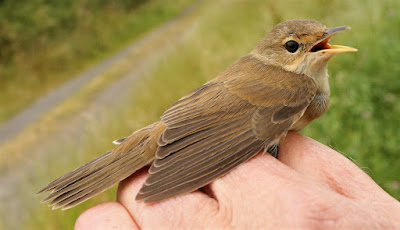There are three updates in one here. Never let it be said that Another Bird Blog doesn’t give regular readers value for money.
On Monday we had two trainee ringers/helpers. M & S are on school holidays so Granddad took them out Pilling way to join up with Andy & Will for a ringing session. Sue said, “Take as long as you like”.
It was a 0630 start for Andy and Will and then 0800 for the three stragglers who saw that the nets were already set with a few birds ready for ringing. The morning was pretty quiet although M & S enjoyed seeing the ringing and then handled a number of species while learning about how to age and sex the birds we processed.
Birds caught - 7 Linnet, 2 Greenfinch, 1 Sedge Warbler, 1 Willow Warbler and 1 Great Tit.
Linnet
Greenfinch
The weather continued in good spirits on Tuesday when Andy and Bryan met up and travelled to Oakenclough. I couldn’t make it because of more school holiday duties but the guys ringed another 15 birds – 5 Willow Warbler, 3 Chiffchaff, 3 Lesser Redpoll, 1 Goldcrest, 1 Garden Warbler, 1 Great Tit and 1 Grey Wagtail.
My chance arrived on Wednesday when another fine morning and no disrupting breeze allowed another visit over Pilling way.
We ringed 10 more new birds – 5 Linnet, 2 Meadow Pipit, 1 Greenfinch, 1 Sedge Warbler and 1 Common Whitethroat.
Meadow Pipit
Common Whitethroat
All ten birds proved to be juveniles/first summer birds.
There was something of a passage of Meadow Pipits on Wednesday morning when about 15/20 of them lined up along a stretch of fence together with 2 Grey Wagtails and 4 Pied Wagtails. We caught two of the pipits but none of the wagtails.
Linnets continued their build in numbers and flock formation whereby we estimated 120/150 throughout the morning in flocks/groups of anything between 5 and 50 individuals.
A juvenile Peregrine entertained us twice with dashing pursuits and at one point flew directly over our vantage point.
Peregrine
Otherwise our birding was quiet in the blue sky morning with visible migration at nil.
Friday looks another “likely” and the very uncommon possibility of four ringing sessions in one week. Bring it on.





































%20(1).jpg)










.JPG)







.jpg)












